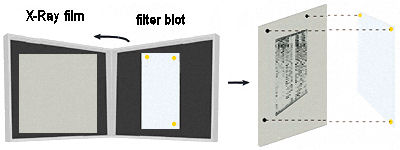
Autoradiography of
biomolecules
Autoradiography is
a class of techniques in which biomolecules are
labelled with radioisotopes such that their
presence and properties can be detected in an autoradiogram
("self-picture").
Radioisotopes such as 14C, 32P,
35S emit radiation that exposes
photographic or X-Ray film. Substitution of 32P
into the backbone of DNA, or 35S
into the sulfur-containing amino acids allows
labelled protein molecules to be detected.
In the particular
experiment shown, a DNA sequencing gel is dried onto
filter paper,
which is placed inside a light-proof X-Ray cassette
box (left) and overlain with a sheet of X-ray film. The cassette is sealed
shut and left for several hours to several days. The film records the
positions of the radio-labelled DNA termination
fragments. The DNA
sequencing "ladder" is read directly from the
autoradiogram.
In other applications, a radio-isotope labelled Southern
Blot filter DNA exposes the film, which when
developed shows a pattern of black bands that indicate
the positions of labelled DNA in the blot. Alignment marks in three of
the four corners are made with radio-luminescent ink
that also exposes the film. The blot can be
aligned with the film by means of the three index marks
(with thee marks, only one alignment is possible). In
related experiments, the alignment can be used to locate
particular DNA bands
at precise positions on the blot, which can then be
recovered for
further experiments.
All text material ©2024 by Steven M. Carr